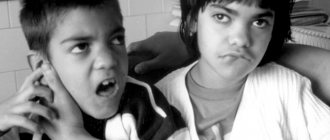Medical information is reliable Checked by Eremin Alexey Valentinovich
Treatment of anxiety personality disorder in Moscow, as in any large city, is relevant. This deviation is characterized by a person’s reluctance to communicate, a feeling of being an inferior person and high sensitivity to criticism directed at him. Social withdrawal in this case is caused by the fear of being ridiculed or humiliated. The disease takes various forms and manifests itself between the ages of 18 and 24 years. At the same time, concomitant disorders appear. Diagnosis is carried out using testing. Psychotherapy and medications are used to provide assistance.
Understanding Anxiety Disorders
At the beginning of the development of the disease, close people notice in a patient with an anxiety disorder his reluctance to communicate with peers and relatives. Then other manifestations of the disorder begin, which persist throughout the rest of life. The extent of its prevalence is difficult to assess, since patients rarely seek timely help. Treatment for anxiety personality disorder is usually carried out by psychiatrists, clinical psychologists and psychotherapists.
Almost always, with this disorder, other mental abnormalities are noted:
- panic disorder;
- agoraphobia;
- social phobia;
- obsessive-compulsive disorder.
Causes of development of anxiety personality disorder
Treatment of anxiety personality disorder is impossible without understanding the cause of the disease. Currently, modern science does not have enough information to clearly formulate the etiology. But it has already been noted that several factors are involved in the emergence of the problem, including genetic predisposition, character traits, temperament, surrounding society and upbringing.
Even in childhood, a tendency to anxiety disorder manifests itself as a child’s poor adaptation to a complex and rapidly changing situation, fearfulness and isolation. But you need to understand that some shyness and timidity when contacting others can act as a normal part of the process of mental development, and has nothing to do with the disease. Normally, this phenomenon goes away over time, but with anxiety disorder, problems with communication and avoidance of contacts persist.
Experts point to the fact that most patients grew up and developed in a family where they were constantly criticized, rejected and not taken seriously. For a child, his parents are always significant people, and therefore the psychotrauma associated with improper upbringing has a strong impact on a person’s future life. A long stay in the absence of emotional intimacy leads to the desire to move away from loved ones.
Symptoms of Anxious Personality Disorder
Before you begin treatment for an anxious personality disorder, you should accurately identify all the symptoms of this pathology. You can already notice some deviations from the norm in a small child. This usually manifests itself this way:
- timidity;
- shyness;
- fear of new acquaintances;
- difficulty answering at the board;
- reluctance to be the center of attention;
- severe discomfort in an unusual situation.
The patient prefers to spend time alone, watch movies, read books and fantasize. His social circle is small and consists mainly of relatives. Constantly keeping strangers at a distance is not due to a lack of need for social contacts, but to the fear of making oneself a laughing stock, of being humiliated and rejected. For such a person, even completely neutral statements from people can cause a strong negative reaction and be perceived as a personal insult.
At the same time, the patient experiences a strong need for emotional intimacy, but he can accept it only under the condition of complete acceptance and goodwill. Even the most insignificant deviation from a gentle atmosphere turns into a tragedy for the patient, evidence of humiliating rejection. For this reason, they often remain lonely. Treatment for anxiety personality disorder should begin as early as possible, since the lack of help will greatly reduce the quality of life of such a person.
When trying to establish contact, a patient with such a disorder experiences great awkwardness and tension. He is not characterized by spontaneity; from the outside he looks shy, clumsy and incomprehensible. Some patients with this disorder, in an attempt to establish communication, may ingratiate themselves with others, and some of them may simply avoid any new acquaintances. They expect constant humiliation, and with their behavior they provoke society into displaying negativity. And this leads to even greater isolation.
Avoidant behavior not only leads to problems in your personal life. It is impossible to build a career under such conditions. A person with an anxiety disorder cannot make professional connections, speak in front of large numbers of people, lead others, or take full responsibility for their decisions. They usually remain in the role of a quiet and inconspicuous subordinate, have difficulty changing their place of residence and work, and rarely make friends among colleagues.
If a patient ends up in a team where he is treated negatively, then this situation leads to rapid decompensation of his condition. Attempts to relieve tension with the help of alcohol or psychoactive substances in such individuals end in addiction to alcohol and drugs.
How to understand that a child has increased anxiety
To help parents - a small self-diagnosis test. Read these statements and think about how they apply to your child. Pay attention to the degree of expression of each point. Single manifestations do not indicate anything, but regular cases, and even with a tendency to worsen, indicate a problem.
So, increased anxiety is present if the child:
- afraid of everything new, unknown;
- tense, constrained, reacts sharply to any unpleasant little thing;
- not confident in himself;
- gets tired quickly;
- absent-minded, performs meaningless actions;
- prone to negativism, sees only the bad in people and events;
- passive, apathetic, difficult to captivate him with anything;
- reacts poorly to criticism;
- feels guilty even in cases where he is not objectively guilty;
- criticizes other people for the slightest mistake;
- complains of bad thoughts, scary dreams;
- sleeps poorly, has difficulty falling asleep;
- cries often;
- cannot bear waiting (for example, in a queue);
- avoids any difficulties
Diagnosis of Anxious Personality Disorder
Treatment of anxiety personality disorder in Moscow at Dr. Isaev’s clinic is carried out only after an accurate diagnosis has been established. To do this, the doctor conducts a conversation with the patient and then evaluates the results of psychological testing. The following identified signs are considered diagnostic criteria in this case:
- constant pressure;
- confidence in one's low value to society;
- constant worry about the opinions of others;
- rejection of criticism;
- reluctance to enter into a relationship when there is no confidence in the person’s sympathy;
- the presence of restrictions in professional and social work.
Identification of an anxiety disorder is carried out after receiving all the examination data and making a differential diagnosis with other mental disorders. Similar symptoms are observed in the following diseases:
- social phobia;
- dependent disorder;
- psychopathy of schizoid type;
- histrionic or borderline personality disorder.
Treatment of social phobia is carried out when a person is not afraid of communicating with another person, but simply cannot tolerate certain social situations. Treatment of psychopathy is carried out under the condition of fear of approaching strangers due to fear of loss of identity. Dependent disorder is characterized by the presence of a phobia of separation, rather than the contact and criticism itself. If a person's behavior is marked by attempts at manipulation and a violent reaction to a negative attitude, then this phenomenon is not considered anxiety, and treatment for hysteria or borderline disorder is carried out.
How to quickly relieve anxiety in a child
Sometimes you need to overcome anxiety here and now. For example, getting ready before a performance or getting ready to go to the doctor. Use the method of the French teacher M. Borba for this. These are simple exercises to quickly relieve stress. Perform them in combination or separately:
- Come up with a phrase that increases self-confidence in a stressful situation. For example: “This will end soon,” “I can handle it,” “I’m safe,” or “Mom is here.”
- Do breathing exercises: take a deep breath through your nose, quickly exhale through your mouth. Teach your child to breathe alternately from the chest to the stomach. Use elevator breathing: after a few deep breaths, close your eyes and imagine that you are in an elevator going down. At this time, hold your breath. As soon as the elevator arrives, you can open your eyes, breathe in and feel that the tension has decreased.
- Teach your child to identify where his stress is. Usually this is the neck, head, lower jaw. Let him tense the muscles of this part of the body several times, and then relax.
- Visualize a comfortable place where the child feels good and calm. For example, in the dentist's chair, let him imagine that he is on a sunny beach, swimming and sunbathing. Taking your thoughts elsewhere will allow you to escape from reality and move through the procedure more calmly.
Treatment of anxiety personality disorder in Moscow
Dr. Isaev’s clinic treats anxiety personality disorder using an individual approach to each person. The patient receives therapy on an outpatient basis. Usually it is successful, this is due to the selection of the most effective methods. The most common methods of psychotherapy in this case are:
- cognitive-behavioural;
- psychoanalytic;
- social skills training;
- individual and group therapy.
The techniques that underlie cognitive behavioral therapy help to detect the presence of distortions of expectations, create a change in thinking and interpretation of events, and teach easy and free communication. Psychoanalysis allows the patient to become aware of his internal conflicts and the reasons for their occurrence, and to reconsider his life in a new light. The main task of a specialist is to help a person overcome his greatly exaggerated fears about his own inadequacy.
The difficulty of working with a patient lies in his tension and constant expectation of rejection. It can be difficult to build a trusting relationship with such a person. When a person begins to talk about his problems, he unconsciously tries to please his psychologist or psychotherapist and find approval for his actions and thoughts. If the patient suddenly decides that he is not understood or is being judged, he stops being frank and immediately closes down. In this case, therapy can be interrupted at the client’s request.
A distinctive feature of a person with an anxiety disorder is his stories about the fear of gossip about him, while he does not express a desire to learn to accept reality. Often the patient has several disorders at once; along with anxiety, he suffers from social and other types of phobia. And all this should be taken into account when prescribing the type of therapy.
The greatest benefit for anxiety disorders comes not so much from individual sessions as from group sessions. There, a person feels in his own environment and can quickly develop communication skills, since the specialist always maintains a warm and friendly atmosphere within the group. It is she who helps relieve stress from the patient.
Treatment of an anxious personality disorder is considered complete at the moment when a person’s new behavior is firmly established. With the right approach, the prognosis for this disease is usually favorable. The forecast for recovery is less optimistic if the disease is complicated by other severe mental disorders.
Pharmacotherapy for anxiety disorder in its pure form is rarely used. It is used as an adjunct, if necessary, for the treatment of depression or other disorders that interfere with acquiring socialization skills and changing behavior.
One of the most common problems with which parents turn to a specialist is increased child anxiety.
According to famous researchers and authors of the book “Emotional Stability of a Schoolchild” B.I. Kochubey and E.V. A new cause of anxiety is the presence of intrapersonal conflict in a child.
Anxiety is an increased tendency to experience emotional discomfort, worry, and worry. It may be associated with anticipation and anticipation of unpleasant experiences or danger. Moreover, even if everything around is good and prosperous, the child may experience a background feeling of impending trouble (fear of the unknown).
There are situational and personal anxiety. That is, in moderate amounts, in certain stressful situations, anxiety is justified and even useful - it mobilizes a person, allows him to avoid danger or cope with a task more effectively. The rest of the time he may feel completely normal and not experience any problems. Personal anxiety accompanies a person in all life circumstances, even objectively favorable ones. That is, it becomes a stable personality trait, influencing all areas of life, self-esteem, motivation, interaction with the environment. A person is accompanied by a feeling of tension, an implicit threat, and any interaction with the outside world is perceived as a source of potential danger, tension and discomfort.
As a rule, a person becomes anxious in childhood. This means that it is important for parents to notice in time the first signs of the formation of personal anxiety in their baby: 1. frequent manifestations of anxiety; 2. difficulty concentrating; 3. increased muscle tone on the face and neck; 4. irritability, severe stiffness or restlessness; 5. sleep disorders; 6. problems with appetite (changes in eating behavior); 7. low performance; 8. uncertainty, tightness, excessive embarrassment (for example, embarrassment even among well-known people). 9. intense gaze; 10. quiet voice; 11. somatic disorders of the body: pain in the abdomen, discomfort from wearing any things, headaches, spasms in the respiratory tract, thirst, decreased tone of the leg muscles; 12. painful reaction to criticism; 13. tendency to blame oneself; 14. criticism of others. · Avoid competition or any type of work involving speed. · Do not compare your child with others. · Trust your child, be honest with him and accept him for who he is. · Use physical contact and relaxation exercises more often. · Help increase your child’s self-esteem by praising him more often, but so that he knows why. · Call your child by name often. · Demonstrate examples of confident behavior and be an example to your child in everything. · Do not place excessive demands on your child. If a child has difficulty in any academic subject, it is better to once again help him and provide support, and if he achieves even the slightest success, do not forget to praise. · Be consistent in raising your child. Do not prohibit without any reason what was previously allowed. · Try to make fewer comments to your child. · Use punishment only as a last resort. · Do not humiliate your child by punishing him. · When communicating with a child, do not undermine the authority of other significant adults. For example, you cannot tell a child: “Your teacher understands a lot, better listen to me!”
· Help him find something he likes, where he could show his abilities and not feel disadvantaged.
For an anxious child, the world around them is frightening and hostile; the child constantly feels depressed, is wary of others and has difficulty establishing new contacts or avoids them altogether. He seeks support and protection from a significant loved one (usually his mother), and often demonstrates his helplessness and lack of independence in order to attract his attention and gain a feeling of security. Over time, this can develop into low self-esteem, a tendency to shift responsibility and lack of independence, and the desire to take the position of a victim.
QUESTIONNAIRE FOR DETECTING ANXIETY IN A CHILD according to Lavrentieva G.P., Titarenko T.M.
Instructions: Please answer certain statements with either “yes” or “no.” 1. Cannot work for a long time without getting tired. 2. It is difficult for him to concentrate on something. 3. Any task causes unnecessary anxiety. 4. While performing a task, he is very tense and constrained. 5. Feels embarrassed more often than others. 6. Often talks about possible troubles. 7. As a rule, blushes in unfamiliar surroundings. 8. Complains of having terrible dreams. 9. Hands are usually cold and damp. 10. There is often upset stool. 11. Sweats a lot when excited. 12. Doesn't have a good appetite. 13. Sleeps restlessly and has difficulty falling asleep. 14. He is timid and fears many things. 15. Usually restless and easily upset. 16. Often cannot hold back tears. 17. Doesn't handle expectations well. 18. Doesn't like to take on new things. 19. I am not confident in myself, in my abilities. 20. Afraid to face difficulties. Add the number of “yes” responses to obtain a total anxiety score. High anxiety – 15 – 20 points. Average – 7 – 17 points. Low – 1 – 6 points. It is important to note that working with anxious children and adolescents is not a matter of two or three meetings; it requires a long time and the active and conscious inclusion of parents in this process (not to say correction of the upbringing process in principle). The main directions in working with anxious children and adolescents are: 1. work to increase and stabilize self-esteem; 2. training in self-regulation skills; 3. Relieving muscle tension. I would like to note that in my practice (I think many colleagues will support me) I see particular effectiveness in working with such children in art therapy methods (from drawing techniques to fairy tale therapy) with elements of body-oriented therapy. The combination of these methods allows you to work through both emotional and physical stress, and teach you how to regulate your emotional and physical state.
It is important for all children to be able to relax, but for anxious children it is simply a necessity, because the state of anxiety is accompanied by tension in various muscle groups.
Teaching a child to relax is not as simple a task as it seems at first glance. Children know well what it means to sit down, stand up, and run, but what it means to relax is not entirely clear to them. Therefore, some relaxation games are based on the simplest way to teach this state. It consists in the following rule: after strong muscle tension, their relaxation naturally follows.
In addition to this principle, these games also use children’s ability to imagine. Here the harmony of soul and body helps us: when a child imagines something very pleasant and calm, his body also relaxes. However, this method only works well with children who have reached preschool age, while the first one can be used at any age.
In addition to special play exercises for relaxation, it is good to use tactile contact with the child; massage and simply rubbing the body are also useful.
Games and exercises
Mouth shut
This exercise will help your child learn to relax his lips and lower jaw, depicting what the figurative expression “Mouth shut!” actually looks like. Have the child purse his lips tightly. Now, without letting go, he will press them in so that they are not visible at all. You need to hold on like this for a few seconds, pleasing your parents with silence, and then you can relax your lips. Emphasize to the child that now his lips are soft and relaxed again.
Note. It is advisable to repeat this game several times for greater effect. To prevent your child from getting bored, you can alternate it with a similar game “Elephant”, when a boy or girl stretches their lips forward like a tube, imitating the trunk of an elephant, and then relaxes them.
Balloon
This game will help you learn to relax your abdominal muscles. First, talk to your child about the last time you inflated balloons. How does the ball change as air enters? Of course, it increases in size and becomes tense, and its walls become difficult to push through with a finger. Now let the child imagine himself as such a balloon. You need to take a very deep breath and hold your breath. Ask the player to place their hand on their stomach and feel if it is round and tight. If you do, you can exhale and feel how nice it is when your stomach is relaxed. Repeat the game three to five more times: tension while inhaling, holding for a few seconds, exhaling and relaxing.
Note. Pay attention to the fact that it is the stomach that is tensed, watch the child’s shoulders - they should not rise. The second important point is that the exhalation should be done without effort; the air will come out on its own if you stop straining your stomach.
Get the star
“To get a star from the sky” means in our language to do something impossible, to achieve fantastic success, to make a dream come true. Well, now you and your child will do this, using your imagination.
Unlike previous games, the child must stand comfortably and close his eyes. Then, as before, he will try to imagine and do what you tell him about. If you want, you can turn on suitable slow music, which will become the sound background for your words:
“Imagine that you are standing in a clearing. Above you is a dark night sky, all strewn with stars. They shine so brightly that they seem very close. The clearing is flooded with soft, gentle blue light. People say that when a star falls, you need to make a wish and it will come true. They also say that the star cannot be reached. But maybe they just didn't try? Find the brightest star in the sky with your mind's eye. What dream does it remind you of? Have a good idea of what you would like. Now open your eyes, take a deep breath, hold your breath and try to reach for the star. It's not easy: stretch with all your might, tense your arms, stand on your toes. So, just a little more, you've almost got it. Eat! Hooray! Exhale and relax, your happiness is in your hands! Place your star in front of you in a beautiful basket. Rejoice looking at her. You did something very important. Now you can rest a little. Close eyes. Mentally look at the sky again. Are there other stars out there that remind you of other cherished dreams? If there is, then take a close look at the chosen luminary. Now open your eyes, breathe and reach for your new goal!”
Thus, this game can be repeated several times while the child still has some important dreams and desires. After you have played, you can discuss with your child the picture that arose in his imagination. If your son or daughter wants, they can even share their dreams with you.
Note. This game, as you already understand, combines both methods of relaxation: mental meditation and alternating intense tension with relaxation. In addition, it has an important psychological meaning - it sets the child up to achieve success, teaches him to believe in the unlimited possibilities of his abilities, and not to give up on his dreams!
It is important for parents to know that:
Anxious children should be given more support and attention should be paid to their resources and qualities that allow them to cope with the challenges that life puts before them.
The child must not only understand, but also constantly be convinced from his own experience that you love him and will love him, regardless of his achievements.
There are so many changes in the constantly changing, developing inner world of a child, so the stability that can be given to him by the confidence and psychological stability of his parents and the solidity of the family system and consistency in upbringing is important.
If changes in the family are inevitable (divorce of parents, moving, illness, death of pets), it is worth talking with the child about these events, taking into account his possible feelings about this (fear, anger, guilt, etc.). Lack of information and unpredictability of life are eternal sources of anxiety.
Anxious children often have difficulty moving from one activity to another (for example, from playing to going for a walk). It is important to warn the child some time in advance about what he will soon have to do so that he is psychologically prepared.
It is useful to discuss the upcoming day with your child and plan things together with him.
The child needs positive messages about his ability to cope with whatever comes his way in life. Not the critical “You made a mistake, that means you are bad,” but an attitude towards mistakes as a positive experience. This will allow the child to engage in new activities without the accompanying anxiety.
It is important to develop adequate self-esteem in a child. To do this, it is best not to evaluate him (either positively or negatively), but to be interested in his activities and their results, asking him how he evaluates his work and why. You should not compare your child with others.
There is no need to force a child to do something that causes him anxiety (for example, he must perform at a matinee, take part in a game, etc.). Wait until he himself wants, until he gains internal readiness for some action.
For anxious children, free play in the fresh air, games with creative materials (cones, pebbles, sand, candy wrappers, etc.), as well as all types of water procedures, except for serious sports activities, are very useful.
It is advisable to gradually get your child interested in drawing with wax crayons and paints (not only with a brush, but also with his fingers), and working with plasticine and clay. It is important for such children to control everything around them, and working with creative material allows them to accept the unpredictability of life through the unpredictability of creativity on “fluid”, not strict material.
If you and your family have a positive and confident outlook on life: “We can handle whatever life throws at us,” then this message will certainly be received by your child, and he will also grow up feeling that he is good and the world around him is interesting. and different.
Questions and answers
Which doctor should you see for an anxiety disorder?
This disease is a variant of the manifestation of neurosis. That's why a psychotherapist deals with it. It can be successfully treated using different methods, but to choose the most effective therapy you need to visit a specialist.
Is it possible to cope with anxiety forever?
An anxiety disorder that is not complicated by comorbid conditions can usually be treated successfully. It is important that a person makes an effort and has the motivation to get rid of the problem.










